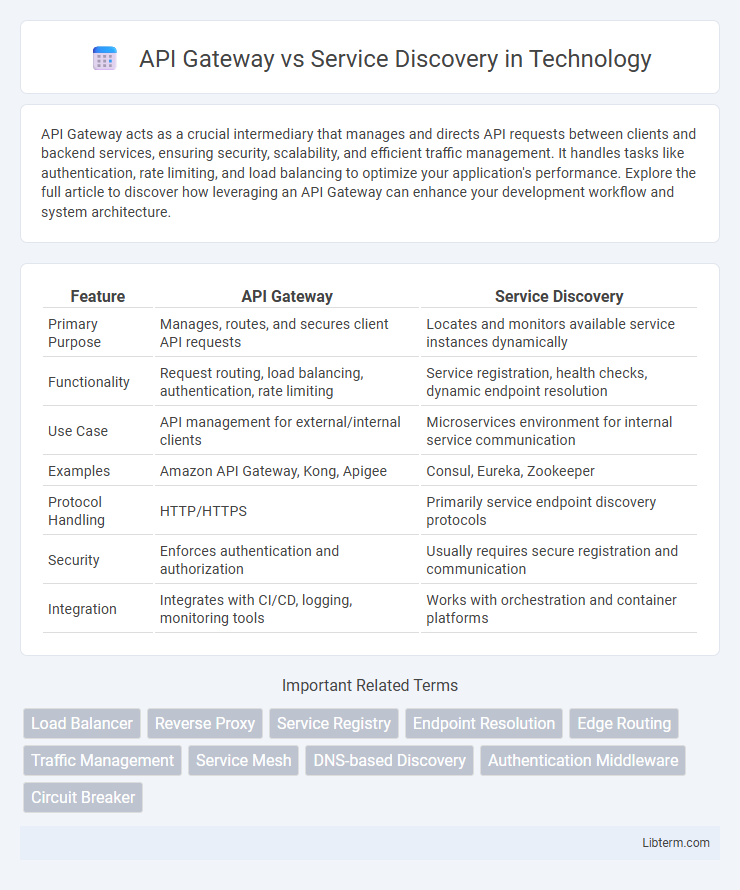API Gateway acts as a crucial intermediary that manages and directs API requests between clients and backend services, ensuring security, scalability, and efficient traffic management. It handles tasks like authentication, rate limiting, and load balancing to optimize your application's performance. Explore the full article to discover how leveraging an API Gateway can enhance your development workflow and system architecture.
Table of Comparison
| Feature | API Gateway | Service Discovery |
|---|---|---|
| Primary Purpose | Manages, routes, and secures client API requests | Locates and monitors available service instances dynamically |
| Functionality | Request routing, load balancing, authentication, rate limiting | Service registration, health checks, dynamic endpoint resolution |
| Use Case | API management for external/internal clients | Microservices environment for internal service communication |
| Examples | Amazon API Gateway, Kong, Apigee | Consul, Eureka, Zookeeper |
| Protocol Handling | HTTP/HTTPS | Primarily service endpoint discovery protocols |
| Security | Enforces authentication and authorization | Usually requires secure registration and communication |
| Integration | Integrates with CI/CD, logging, monitoring tools | Works with orchestration and container platforms |
Introduction to API Gateway and Service Discovery
API Gateway acts as a centralized entry point managing client requests, routing them to appropriate microservices, and handling tasks such as authentication, rate limiting, and load balancing. Service Discovery maintains an up-to-date registry of service instances, enabling dynamic detection and communication between microservices without hard-coded addresses. Both technologies optimize microservices architecture by improving service management, but API Gateway focuses on external request handling while Service Discovery ensures internal service connectivity.
Core Concepts: What is an API Gateway?
An API Gateway acts as a centralized entry point that manages, secures, and routes client requests to multiple backend services, enabling efficient traffic control and protocol translation. It provides features like request throttling, authentication, load balancing, and response transformation to streamline API management. Unlike service discovery, which dynamically locates service instances, the API Gateway focuses on aggregating and exposing APIs with enhanced security and operational control.
Core Concepts: What is Service Discovery?
Service Discovery is a critical microservices architecture component that automates the detection of network locations for service instances. It maintains an up-to-date registry of service endpoints and enables dynamic routing by allowing services to locate and communicate with each other without hard-coded IP addresses. Unlike an API Gateway, which acts as a single entry point for managing and securing client requests, Service Discovery focuses specifically on enabling efficient inter-service communication within distributed systems.
Key Differences Between API Gateway and Service Discovery
API Gateway acts as a centralized entry point that manages, routes, and secures client requests to multiple backend services, providing features like authentication, rate limiting, and load balancing. Service Discovery functions by dynamically locating microservices instances within a distributed system, enabling services to find each other without hard-coded addresses. The key difference lies in their roles: API Gateway handles client-to-service communication and security, while Service Discovery manages internal service-to-service connections and network resolution.
How API Gateway Works in Microservices Architecture
API Gateway acts as a single entry point that routes client requests to the appropriate microservice, handling tasks such as request routing, authentication, rate limiting, and load balancing. It abstracts the internal microservices network by consolidating multiple service endpoints into a unified API interface, simplifying client interactions. Unlike Service Discovery, which dynamically locates microservices instances by maintaining a registry, the API Gateway centralizes communication and enforces policies, improving security and performance in microservices architecture.
How Service Discovery Simplifies Service Communication
Service discovery automates the detection of network locations for microservices, enabling dynamic routing without manual configuration. It maintains an updated registry that services query to locate and communicate with each other efficiently, reducing latency and errors. Unlike API Gateway, which centralizes request routing and policy enforcement, service discovery provides decentralized, real-time service endpoint resolution essential for scalable microservices architectures.
Use Cases: When to Use API Gateway vs. Service Discovery
API Gateway is ideal for managing client requests, handling authentication, rate limiting, and aggregating multiple service responses in microservices architectures. Service Discovery excels when dynamically locating and connecting microservices instances in a constantly changing environment, especially in container orchestration platforms like Kubernetes. Use API Gateway for securing and simplifying external API access, while use Service Discovery for internal service-to-service communication and load balancing.
Pros and Cons of API Gateway
API Gateway centralizes API management, offering benefits like request routing, security enforcement, rate limiting, and protocol translation, which streamline client access to microservices. However, it may introduce latency, create a single point of failure, and increase operational complexity due to the necessity of managing and scaling the gateway infrastructure. Unlike Service Discovery, which dynamically locates services, API Gateway primarily focuses on aggregating and securing API traffic, making it less suitable for dynamic service registration and health checks.
Pros and Cons of Service Discovery
Service Discovery enables dynamic detection of microservices, enhancing scalability and resilience by automatically updating service locations without manual intervention. It reduces configuration overhead and supports real-time updates in distributed systems but may introduce complexity in managing service registries and handling network partitions. However, challenges include increased latency due to registry lookups and potential single points of failure if the discovery mechanism is not properly replicated.
Selecting the Right Solution for Your Architecture
API Gateway centralizes request routing, authentication, and rate limiting, making it ideal for managing external client interactions in microservices architectures. Service Discovery dynamically tracks service instances and their availability, ensuring efficient internal service-to-service communication within distributed systems. Choosing between API Gateway and Service Discovery depends on whether the architecture requires managing external client requests or enabling seamless internal service connectivity for scalability and resilience.
API Gateway Infographic

 libterm.com
libterm.com